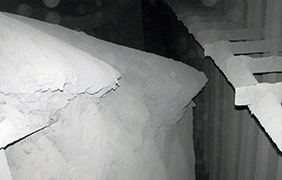Optimizing Your Precipitator: Internal Components
If your precipitator isn’t working as well as it should, the very first place to troubleshoot is inside. Plates, discharge electrodes (wires) and other internal components are the bones of the precipitator, and if they’re not installed or maintained properly, you will have performance issues. Start by assessing clearances. The distance between wires and plates is the most basic, important aspect of an ESP’s performance. If clearances are not set correctly, the result is reduced voltage, increased wire failure, more loading to downstream fields, and other problems.
It should be standard procedure before every outage to review ESP performance data to pinpoint areas that need attention. Look for lower than normal kV and mA readings; wherever these show up, mark the sections as places to focus your troubleshooting efforts. Then, during the outage, check the marked sections for clearance problems.
Re-aligning clearances might be simple, or might be complicated. In some cases, all you need to do is re-hang/replace falling or fallen wires. You might find localized plate warping caused by high hoppers, and this might necessitate replacing some of the plates. If that’s not feasible during the outage, a shortcut is to simply pull out wires in sections where there are clearance issues. Sure, you’ll lose some potential collecting capacity, but it will be made up for in overall improved performance. One bad apple, as they say, can spoil the whole barrel.
It can’t be emphasized enough: installing and maintaining appropriate internal components–wires, plates, etc.–is vital to optimal ESP performance. Even the type of discharge electrode used makes a huge difference. For example, if there is very heavy dust loading, switching from weighted wires to another type can significantly improve performance, especially at the inlet field.
If you’re planning an ESP rebuild or major set of replacements, start by assessing clearances. Consider changing the spacing between plates and switching to a more appropriate type of discharge electrode for a one-two punch. It makes a lots of sense to precisely match the discharge electrode geometry to properties of the particulate being collected, and related factors. For example, rigid discharge electrodes or barbed wires can be designed to help overcome low current levels produced by high space charge.
Also, consider the role rappers play. Older precipitators often have greater plate area per rapper than current designs. Increasing the number of rappers can help maintain power into the electrical fields and reduce the magnitude of opacity spikes.
As with a lot of other things in life, optimizing your precipitator starts from the inside out. If you avoid shortcuts anywhere, make internal components that place.
Helpful Resources
KnowledgeBase: Major Components Overview
KnowledgeBase: Equipment Improvements
Our Capabilities: Performance-Based Maintenance
Our Capabilities: Precipitator Internals


